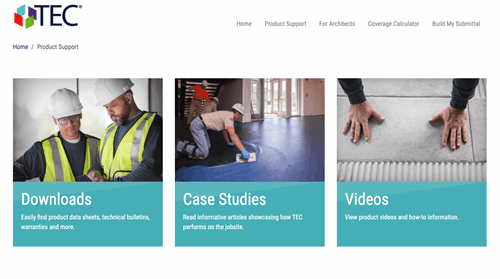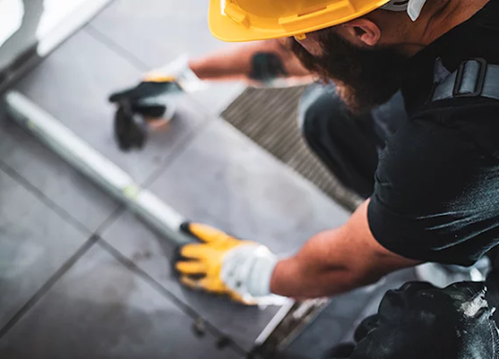6 Ways Contractors Can Reduce Operating Costs
Minimizing operating costs to make every project more profitable requires a commitment to continuous improvement.
You can make many big and small moves that make a difference, but your mindset matters most. Committing to constant scrutiny of your business and continuous improvement has to happen before anything else.
Having made those commitments, focus on these often-overlooked tactics to achieve your overall cost-reduction strategy.
1. Lean On the Manufacturer’s Expertise

Take advantage of flooring and tile manufacturers’ wealth of product knowledge. They should offer a large volume of technical content such as downloadable documents and videos.
You should have access to job-costing tools such as product coverage calculators that can help you accurately estimate the cost of materials. Also, you should have several ways to communicate with them: web forms, email and, most importantly, a technical support number.
Utilize manufacturers’ expertise at the project planning stage. TEC® has multiple resources to answer questions during project planning and subsequent construction stages. For example, contractors can access our technical support team via a toll-free number Monday through Friday.
In addition, technical managers and sales representatives are available to handle questions from contractors in their local area. For larger projects, they can even provide onsite troubleshooting and expert guidance on the proper use of TEC® flooring and tile products.
2. Prevent Difficulties By Conducting a Project Practice Run
Conducting a project practice run enables you to eliminate problems before work starts. Tom Sheridan, principal at PCI FlorTech in Addison, IL, and his foreman and supervisors are often accompanied by a technical advisor from the manufacturer on the job site to help them plan and outline the project ahead of time.
By minimizing delays and downtime, this process has the biggest cost-minimization impact of any single PCI FlorTech practice, Sheridan says. It also differentiates the company from competitors, he adds.
Sheridan shows up at the job site before work starts and sets up the job path — an ‘assembly line’ of material staging and mixing areas. This practice minimizes bottlenecks and enables crews to ramp up to full production at the start of the shift, ultimately saving time and labor.
A practice run is particularly critical for projects where product deployment or staging is a challenge. One example is installing large format tile (LFT) such as gauged porcelain tile/panels (GPTP) several stories high.
First, make sure there is sufficient space outside the building to unload the panels and that there is enough space for staging if necessary.
Next, inspect the route to the installation area. Scout out hallways and stairways, including corners, to ensure sufficient space for handling and transport. Determine if your crew needs to transport the panels on an elevator and, if so, ensure freight elevator availability.
If the building has only a passenger elevator, you might need to arrange exclusive use for a certain period with building management. In addition, make sure the elevator is large enough to accommodate the panels. Working around other people, whether the public or other trades, is always a consideration.
Also, make sure the installation area has enough space for panel storage. Confirm that you can set up a table that is large enough to support an entire panel near the installation area, with clearance on all sides. Set up this work area near water and electricity sources if possible.
3. Operationalize Quality Control and Training
To ensure owner satisfaction and keep operating costs at a minimum, use construction quality management (CQM) principles. A quality control program, an essential part of CQM, requires you to:
- Define how project quality will be managed throughout the project.
- Identify who is responsible for meeting the quality standards.
- Define how quality standards are to be met.
- Specify procedures and practices to ensure adherence to the standards.
Address each of these requirements by training crews on the products you use. Training is important because it makes workers more confident and productive, and it eliminates the need for crews to read instructions once the project starts. Better yet, it prevents incorrect product use. The result is fewer callbacks and more profitable work.
TEC® offers comprehensive hands-on installation training events to help contractors ensure that their crews achieve successful outcomes. Product support videos offer contractors a flexible alternative.
4. Ruthlessly Attack Hidden Costs
Seemingly insignificant hidden costs can add up. Evaluating the products you use and your supply arrangements is a good exercise to undertake from time to time for reducing these hidden costs.
Make sure you’re keeping up with the latest in product technology so you can offer customers the most value while maintaining healthy profit margins. Some materials are developed to provide labor savings as a major benefit.
For instance, high-flow, self-leveling underlayments reduce the amount of labor by eliminating the tasks of sanding or skim coating. Other materials are designed to do “double duty.” One example is a product that offers both waterproofing and crack isolation. Another example is a grout that does not require sealing.
Some of these products will be available from more than one manufacturer, so check product data sheets to compare attributes. Often, such comparisons are much more valuable than price considerations. While the price of one product might be relatively high, it might ultimately reduce your operating costs because of better coverage or properties that save labor costs, for instance.
Even if you have good long standing relationships with product and equipment suppliers, keep them honest by shopping around from time to time. You might find that you can get a lower price elsewhere. When comparing prices, consider factors such as quality, performance, convenience and ease of use to uncover total costs, including time and labor.
Time is money, so focus on opportunities to save time. For example, work delays often happen when workers lack the tools and equipment they need before and during a shift. Their time spent looking for these assets does not enhance your bottom line.
Tool and equipment inventorying is essential and automating the process is ideal. You can view asset-tracking systems as another operating cost, but they can reduce or eliminate work delays and save money. These systems often pay for themselves quickly.
Also, challenge your own assumptions. For instance, some of your workers might not need a company vehicle. Mileage reimbursement for use of personal vehicles for work purposes is a cost-saving alternative.


5. Invest in Efficiency-Enhancing Equipment
When you invest in equipment that gives you economies of scale, you can complete projects faster and more profitably. That also enables you to grow your business.
For example, PCI FlorTech has replaced its ‘bucket on a dolly’ with a HIPPO mixer for greater productivity on projects that use self-leveling underlayment. The HIPPO mixer uses five bags of self-leveling underlayment rather than two in one placement, more than doubling material placement productivity.
To maximize the production rate, Sheridan says, you can invest in mixer-pumps that place 200–300 bags of underlayment compound per hour, compared with a HIPPO mixer’s 60 bph.
6. Take Care of Your People
Don’t limit investments to capital equipment and flooring materials. Keeping your workers comfortable and productive can pay off by minimizing rework and turnover. Happy employees are more likely to stay motivated and loyal. Listen to their concerns and give them what they need to be successful.
Sheridan’s philosophy is to treat his employees like family. He constantly keeps a lesson from his grandfather in mind: Never forget what it was like to be an employee. Sheridan’s day-to-day actions reflect his philosophy.
It starts with providing his crews with the highest-quality materials, tools and equipment he can find to ensure that the job gets done right. Also, workers are more likely to take care of high-quality tools, Sheridan points out.
Sheridan also understands that incentives breed worker loyalty. When projects are completed under budget, workers receive rewards such as new tools, gift cards and local weekends. Also, when employees log two years of service, they get a pair of premium knee pads and a new pair every time they wear out.
Make the Change
Committing to change and anticipating unnecessary operating costs by adopting these tactics can help you keep your company profitable. Your competitors have access to the same improvements in technology, so an improvement mindset and continuous learning are your competitive advantages, now more than ever.
You can address the first tactic on this list by leaning on our product expertise on your next flooring or tile project. Our Technical Support team is here to help Monday through Friday from 7 a.m. to 6 p.m. CST. Contact them at 1-800-TEC-9023 (1-800-832-9023) or send your question via our online form.
